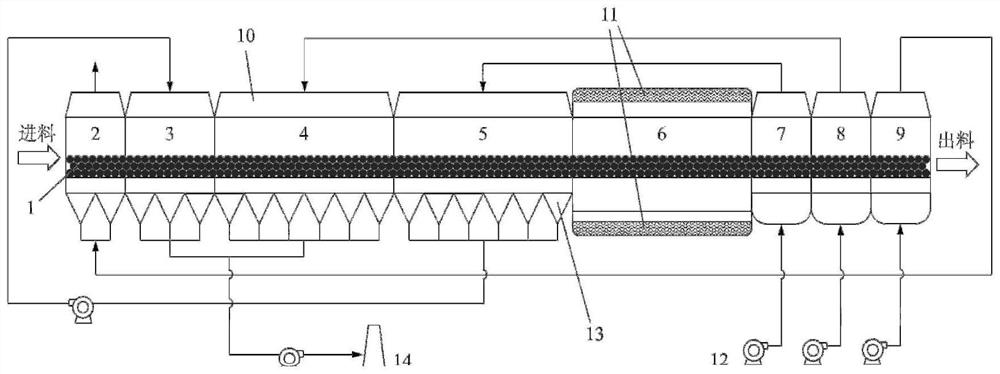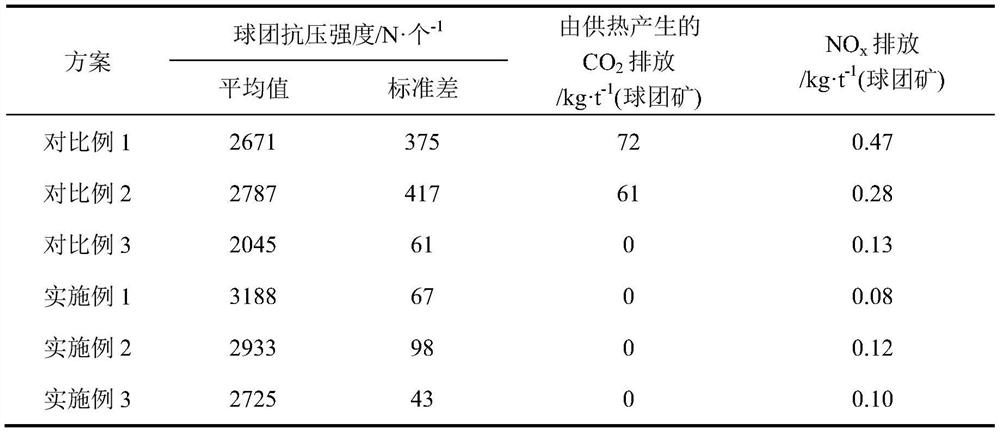Pellet production process adopting microwave low-temperature carbon-free roasting
A production process and microwave generator technology, applied in the direction of improving process efficiency, etc., can solve the problems of uneven pellet roasting, flue gas pollutant emissions, and high roasting temperature, so as to reduce energy consumption and achieve zero carbon emissions , the effect of reducing the emission of flue gas pollutants
- Summary
- Abstract
- Description
- Claims
- Application Information
AI Technical Summary
Problems solved by technology
Method used
Image
Examples
Embodiment 1
[0037] Aiming at the microwave low-temperature carbon-free roasting pellet technology proposed in the present invention, 98.8% magnetic and hematite mixed iron concentrate raw materials (magnetite:hematite=7:3) are used, and 1.2% bentonite is added to prepare acid pellets. In the process, the pellet thickness is 200mm, the pellet size is 8-13mm, the microwave frequency is 2450MHz, and the thermal system is blast drying at 350℃ for 2min, 500℃ for 4min, preheating at 800℃ for 6min, and preheating at 1050℃ for 10min. After preheating, the FeO content in the pellets was 2.2%, and the desulfurization rate of the pellets was 92.3%; the finished pellets were obtained under the thermal regime of roasting at 1180 °C for 8 min and cooling rate of 80 °C / min. Pellet indicators, carbon emissions during pellet production, NO x Emissions are shown in Table 1.
Embodiment 2
[0039] Aiming at the microwave-based low-temperature carbon-free roasting pellet technology proposed in the present invention, magnesium is prepared by using 91.2% magnetic and hematite mixed iron concentrate, adding 0.5% organic binder (CMC), 3.8% magnesite and 4.5% limestone. Mass flux pellets (basicity 0.4, MgO content 2.0). In the process, the pellet thickness is 200mm, the pellet size is 8-13mm, the microwave frequency is 915MHz, and the thermal system is 300°C blast drying for 3 minutes, 450°C exhaust drying for 5 minutes, 1000°C preheating for 8 minutes, and 1150°C preheating for 8 minutes. After preheating, the FeO content in the pellets was 1.8%, and the desulfurization rate of the pellets was 88.3%; the finished pellets were obtained under the thermal regime of roasting at 1250 °C for 10 min and cooling rate of 50 °C / min. Pellet indicators, carbon emissions during pellet production, NO x Emissions are shown in Table 1.
Embodiment 3
[0041] Aiming at the microwave low-temperature carbon-free roasting pellet technology proposed by the present invention, 96.3% vanadium-titanium magnetite is used, 1.6% bentonite and 2.1% magnesium oxide powder are added to prepare magnesia vanadium-titanium pellets (MgO content 2.0%). During the process, the pellet thickness is 100mm, the pellet size is 8-13mm, the microwave frequency is 2450MHz, the thermal system is blast drying at 250℃ for 3min, 400℃ for 5min, preheating at 1000℃ for 10min, and preheating at 1150℃ for 6min. After preheating, the FeO content in the pellets was 2.7%, and the desulfurization rate of the pellets was 89.5%; the finished pellets were obtained under the thermal regime of roasting at 1230 °C for 12 min and cooling rate of 50 °C / min. Pellet strength index, carbon emissions during pellet production, NO x Emissions are shown in Table 1.
[0042] Table 1 implements the pellet strength index produced by the process of the present invention
[0043] ...
PUM
| Property | Measurement | Unit |
|---|---|---|
| thickness | aaaaa | aaaaa |
| particle size | aaaaa | aaaaa |
Abstract
Description
Claims
Application Information
 Login to view more
Login to view more - R&D Engineer
- R&D Manager
- IP Professional
- Industry Leading Data Capabilities
- Powerful AI technology
- Patent DNA Extraction
Browse by: Latest US Patents, China's latest patents, Technical Efficacy Thesaurus, Application Domain, Technology Topic.
© 2024 PatSnap. All rights reserved.Legal|Privacy policy|Modern Slavery Act Transparency Statement|Sitemap


